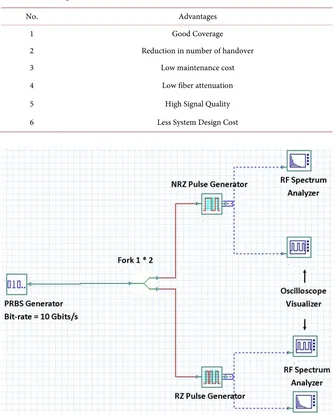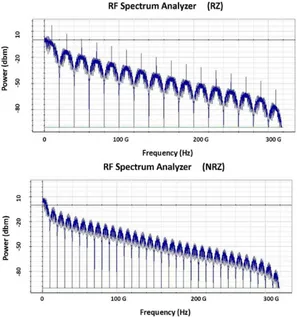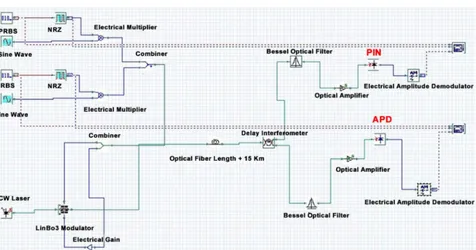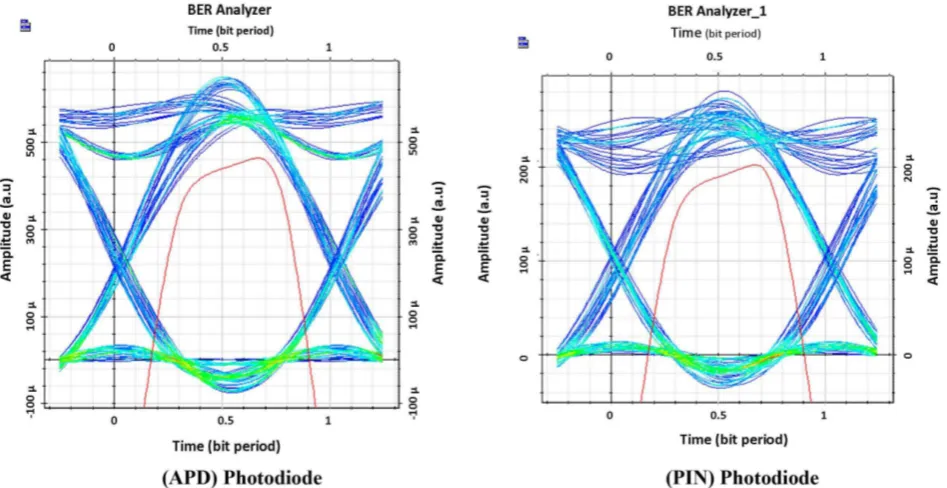DOI: 10.4236/jcc.2017.513001 Nov. 9, 2017 1 Journal of Computer and Communications
Analysis, Maintaining Signal Integrity
Rao Kashif, Oluwole John Famoriji, Fujiang Lin
Department of Electronic Engineering and Communication, University of Science and Technology, Hefei, China
Abstract
Radio over fiber is an integration of microwave and optical fiber technologies having numerous benefits. RoF technology can give a scope of advantages in-cluding the capacity for backing multiple radio services and standards. In or-der to maintain Signal Integrity in RoF system, it’s indispensable to take all components of a system under rooted consideration. Due to the increasing number of RoF application, it’s necessary to do some system level changes in designing RoF transceiver. In this paper we compared two popular modula-tion techniques NRZ (non return to zero) and RZ (return to zero) for better signal integrity in RoF system. Secondly we also did analysis of RoF transceiv-er with APD and PIN photo detectors and compared the ptransceiv-erformance on dif-ferent distances. Hence the Q factor of PIN and APD photo diodes and com-parison of NRZ and RZ modulation will be helpful for system designers who are working on better signal Integrity in Radio over fiber systems.
Keywords
RoF, PIN, APD, NRZ, RZ & Photodiode
1. Introduction
With Radio over Fiber is just sending the radio signals over optical fiber. Easy maintenance, low power units, simple remote antennas, low attenuation loss, large bandwidth and reduced power consumption are few benefits of RoF link. RoF is an auspicious solution to accomplish the increasing demand of wireless and user bandwidth. In RoF system the only task of Base station is to convert optical signal into Radio signal. Figure 1(a) shows layout of simple bidirectional directly modulated RoF link. Modulation, multiplexing, coding are performed at Central Unit CU. The receiver consists of Photodiode to provide an RF power output proportional to the square of the input optical power. In recent
How to cite this paper: Kashif, R., Famo-riji, O.J. and Lin, F.J. (2017) Radio over Fiber System Level Performance Analysis, Maintaining Signal Integrity. Journal of Computer and Communications, 5, 1-8. https://doi.org/10.4236/jcc.2017.513001
Received: September 8, 2017 Accepted: November 6, 2017 Published: November 9, 2017
Copyright © 2017 by authors and Scientific Research Publishing Inc. This work is licensed under the Creative Commons Attribution International License (CC BY 4.0).
DOI: 10.4236/jcc.2017.513001 2 Journal of Computer and Communications (a) (b)
Figure 1. (a) Simple RoF link; (b) RAU with EAM.
advancement laser, photodiode and circulator are replaced with a single elec-tronic device called electro absorption modulator [1] as shown in Figure 1(b). EAM acts as photodiode for downlink and modulator for uplink. No light source is needed at RAU which makes it much simpler and cheaper. In 2012 A. Kumar & N. Agarwal worked on RoF integration microwave and optical communica-tion access to broadband wireless communicacommunica-tions [2]. Three methods imple-mented into RoF and compared with Attenuation, Scattering, BER and CNR.
Satellite Communication, mobile radio communication, broadband and wire-less LAN are few application of RoF. Table 1 shows few advantages of RoF in mobile communication network [3][4][5][6]. Laser diode non linearity is one of the major drawbacks of RoF which gives rise to inter modulation distortion and clipping noise. Signal Integrity is one of the biggest concerns for system de-signers [7] [8]. System level research and designing helps engineers to achieve their goals of signal Integrity in any network or systems.
2. Modulation Techniques
First step in optical system designing is to select right modulation technique. Modulation technique converts electrical signal into bit stream. We compared two well-known modulation NRZ (Non return to zero) and RZ (return to zero). Both techniques were analyzed with PRBS bit generator at 10 GB rate as shown in Figure 2.
The binary data should be encoded into electrical signal or optical waveform signal. NRZ is most commonly used binary data encoding. In NRZ bit period is the time given to transmitted bit where high amplitude is 1 and low amplitude is 0 and the sequence is called stream [9]. In RZ every bit will return to zero [10]. The pulse in NRZ have more energy than RZ one. Low cost and simple engi-neering makes NRZ most favorite. For optical communication system which is working on 10G or above the RZ increases transmit distance. In optical domain an extra Mach-Zehnder modulator is used, which is an expensive solution, But in electrical a high speed OR gate can be used as a cost efficient solution [11]. NRZ is not self-clocking so additional techniques should be used to avoid bit slip
[11]. Synchronization in NRZ is handled via square wave signal known as bit clock [9].
DOI: 10.4236/jcc.2017.513001 3 Journal of Computer and Communications
4 Low fiber attenuation
5 High Signal Quality
6 Less System Design Cost
Figure 2. NRZ & RZ modulation.
between each bit. NRZ took half the bandwidth as shown in Figure 4. So it’s more data efficient. Finally eye diagram on receiver side of both NRZ & RZ are shown in Figure 5.
3. Radio over Fiber System Design Analysis
Now a day’s RoF applications are expanding and after significant contribution in telecommunication it’s also benefiting the short range and LAN networks. While working on different scenarios for maintaining signal integrity in RoF network it’s also mandatory to check the system design techniques and select right com-ponent for transceiver designed for specific networks or scenarios. Figure 6
[image:3.595.206.541.82.497.2]DOI: 10.4236/jcc.2017.513001 4 Journal of Computer and Communications
Figure 3. NRZ & RZ oscilloscope analysis.
[image:4.595.225.522.376.693.2]DOI: 10.4236/jcc.2017.513001 5 Journal of Computer and Communications
Figure 5. NRZ & RZ eye diagram.
Figure 6. RoF system design with PIN & APD Photo detector.
[image:5.595.64.540.352.602.2]DOI: 10.4236/jcc.2017.513001 6 Journal of Computer and Communications
Figure 7. PIN & APD Q-factor graph.
Figure 8. APD and PIN photodiode Eye diagrams.
photo detector. Figure 7 shows the comparison of both photo detectors on 5, 10 and 15 Km network. Figure 8 shows eye diagram of PIN and APD photo detec-tor at 15 Kilometers.
[image:6.595.66.540.336.580.2]DOI: 10.4236/jcc.2017.513001 7 Journal of Computer and Communications
4. Conclusion
Two well-known modulation techniques NRZ and RZ were analyzed and NRZ (non-return to zero) was found more data efficient due to less bandwidth usage than RZ modulation. Secondly APD and PIN photo detectors were simulated in RoF system. From simulation results performed with different network lengths, it was cleared that APD is the best candidate for maintaining signal integrity in long networks. Selecting right modulation technique and Photo detector can improve the Integrity of Radio over Fiber system. Still work can be done on oth-er components and improve system poth-erformance.
Acknowledgements
This research is supported by CAS-TWAS. We are thankful to all teacher and fellow colleague of MESIC for their contribution.
References
[1] Lach, E., et al. (2005) Application of Electro Absorption Modulators for High-Speed Transmission Systems. Journal of Optical and Fiber Communications Reports, 2, 140-170. https://doi.org/10.1007/s10297-005-0032-6
[2] Karthikeyan, R. and Prakasam, S. (2013) A Survey on Radio over Fiber (RoF) for Wireless Broadband Access Technologies. International Journal of Computer Ap-plications, 64, No.12. https://doi.org/10.5120/10686-5587
[3] Al-Raweshidy, H. (2002) Radio over Fiber Technology for Next Generation. Artech House Publishers, Norwood.
[4] Kashif, R. and Lin, F.J. (2015) Signal Integrity Problems in Electronic Designing.
Proceeding of. Asia-Pacific Microwave Conference (APMC), Nanjing, 6-9 Decem-ber 2015. https://doi.org/10.1109/APMC.2015.7412979
[5] Way, W.I. (1993) Optical Fiber-Based Microcellular System: An Overview. IEICE Transactions on Communications, E76-B, 10911-11102.
[6] Kajiya, S., Ksukamoto, K. and Komaki, S. (1996) Proposal of Fiber-Optic Radio Highway Networks Using CDMA Method. IEICE Transactions on Electronics, E79-C, 496-500.
[7] Liu, J., et al. (2008) Waveguide-Integrated, Ultralow-Energy GeSi Electro-Absorption Modulators. Nature Photonics, 2, 433-437.https://doi.org/10.1038/nphoton.2008.99 [8] Fan, J., Ye, X.N., Kim, J., Archameault, B. and Orlandi, A. (2010) Signal Integrity Design for High-Speed Digital Circuits: Progress and Directions. IEEE Transaction on Electromagnetic Compatibility, 52, 392-400.
https://doi.org/10.1109/TEMC.2010.2045381
DOI: 10.4236/jcc.2017.513001 8 Journal of Computer and Communications (HFAN-09.0.0). http://www.maximintegrated.com/en/app-notes/index.mvp/id/870 [10] Liang, H., Li, W., Linze, N. and Zhang, X. (2010) Comparison of Return-to-Zero
and Non-Return-to-Zero Coded Pulses for BOTDA. The 9th International Confe-rence on Optical Communication and Networks (ICOCN 2010), Nanjing, 24-27 October 2010, 31-35.https://doi.org/10.1049/cp.2010.1146
[11] Schwanke, B. and Nellis, K. (2009) NRZ-to-RZ Data Conversion Using High Speed OR/AND. Electronic Product.




